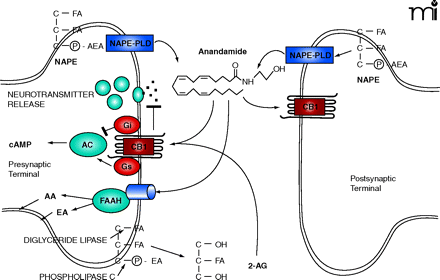
- Institution: Stanford Univ Med Ctr Lane Med Lib/Periodical Dept/Rm L109
- Sign In as Member / Individual
Cannabinoids Biology: The Search for New Therapeutic Targets

The Endocannabinoid Synapse NAPE (N-arachidonoylphosphatidyl ethanolamine) is hydrolyzed by NAPE phospholipase D (NAPE-PLD) to release free anandamide (AEA). Alternatively, precursor phospholipids are hydrolyzed by diglyceride lipase and phospholipase C to release the resident fatty acid (FA) from the sn-1 position and phosphatidyl-ethanolamine (p-EA) from the sn-3 position, respectively, yielding 2-arachidonoylglycerol (2-AG). Anandamide and 2-AG are agonists at the CB1 receptor. Anandamide can also be released from postsynaptic terminals to signal in a retrograde fashion to presynaptic CB1 receptors. The CB1 receptor either blocks or stimulates adenylate cyclase (AC) depending on cell type. CB1 receptors block neurotransmitter release from the presynaptic terminal. Disposal of anandamide, to yield EA and arachadonic acid (AA), and 2-AG is via movement across the plasma membrane followed by hydrolysis by cytoplasmic fatty acid amide hydrolase (FAAH). As discussed in the text, this movement of anandamide may involve a protein transporter (blue cylinder) that may work in conjunction with FAAH. 2-AG is also transported across the plasma membrane by a similar process and hydrolyzed by monoacylglyceride lipase.


